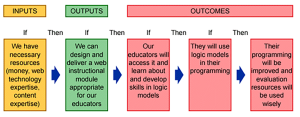Home » Enhancing Program Performance with Logic Models » Section 3: More about Your Program “Logic” » 3.3: If-then relationships
3.3: If-then relationships
People often talk about logic models talk as a series of “if-then” sequences. Reading from left to right, a logic model portrays a series of if-then relationships. If “x”, then “y”. If “y”, then “z”. Play the video to see how this works.
These “if-then” relationships may seem too simple and linear for the complex programs and environments in which we work.

However, we find that in working out these sequences, we uncover gaps in logic, clarify assumptions, and more clearly understand how investments are likely to lead to results.
Where we have sound research, the if-then relationships are clear and strong. Often, however, we work in situations, and with issues and audiences, where the research base is not well developed. It is your “theory” or “theories” – the explanation that links program inputs with activities to outcomes – the chain of response – that leads to ultimate, end results.
Instructional Module: Example

Family Support Initiative: Example

Assumptions for the Family Support Initiative
- There is the assumption that a resource inventory is linked to improvement in client well-being and that the program will have the necessary time, money, and expertise to develop the resource inventory.
- There is the assumption that once the resource inventory is developed, people will use it, particularly the identified target group.
- There is the assumption that once accessed, the service will, in fact, meet the client’s need.
- Also, there is the underlying assumption that interagency coordination will make a difference relative to these families’ needs.
When developing a logic model, think about the underlying assumptions. Are they realistic and sound? What evidence or research do you have to support your assumptions?




